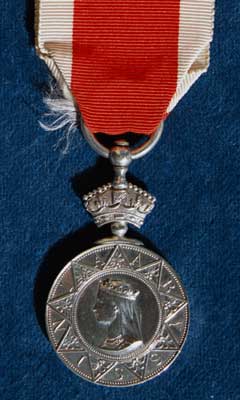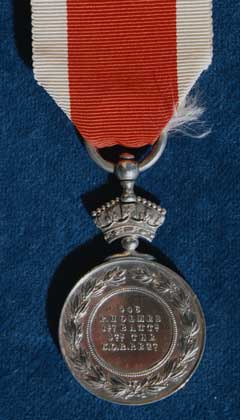MEDAL INFORMATION
Abyssinia Medal (4 October 1867 to
19 April 1868)
Face
A coroneted and veiled
bust of Queen Victoria surround by an ornamented, nine-pointed star.
Between the points of the star are the letters of the word ‘ABYSSINIA’
Reverse
Within an encircling
laurel wreath the plain central disc bears the Number, Name and Regiment
of the recipient in embossed lettering, the pattern of which varies. Most
of the native Indian troops received medals with engraved naming.
Size
The disc of the medal
is approx 32 mm in diameter. The length of the medal over the ring
suspender is approx 69mm. The medal is of silver.
Ribbon
Approximately 39 mm
wide red with white edges, each approx 9 mm wide.
Suspension
The ribbon is threaded
through a ring approx 18 mm diameter fixed by a swivel fitting to the top
of an Imperial crown. Beneath the crown, and integral with it, is an
ornamental connecting piece which is sweated on to the top edge of the
disc. Medals with signs of repair to this joint are quite common.
Naming
Embossed in square
capitals on the reverse of the disc for British recipients (see above).
Awarded
To all Royal Navy and
British and Indian Army personnel who took part in the campaign against
King Theodore of Abyssinia. The King had imprisoned the British Consul,
the British Political Resident at Aden and a number of missionaries and
other Europeans because of an imagined slight on his Sovereignty by Queen
Victoria and the British Government. The small expedition under
Lieutenant General Sir Robert Napier was sent from India in December 1867.
Following its incompetence in organisation and generalship displayed in
the Crimean Campaign, the British Army was ‘on trial’ before its European
contemporaries.
The isolated position of
Theodore’s stronghold at Magdala meant constructing a base port on the Red
Sea coast and supplying the Army on its march of almost 400 miles to
Magdala through virtually unknown barren, mountainous country in the face
of unfriendly natives and possible dangers from wild animals. To be a
success the expedition had to be completed in six months, before the rainy
season made the normally inhospitable terrain completely impassable. This
depended largely on the efficiency of the logistical support.
The expedition set out at the
end of January 1868 and after the decisive battle of Arogie on Good
Friday, 10th April, Magdala was stormed and taken on the Easter Monday.
Theodore shot himself on sight of the first troops breaching the defences,
whereupon opposition ceased and the prisoners were freed. On 19th April
the Army began its long march back to the coast, where it arrived at the
end of May, having executed a campaign notable for the fact that its
purpose was not the occupation or colonisation of a country. Moreover,
its success and the manner in which it was achieved served to re-establish
the reputation of the British Army in the eyes of the World.
The King’s Own
The 1st Battalion, 4th
(The King’s Own Royal) Regiment left Bombay in mid-December 1867 and
disembarked at Zoulla on the African Coast on 3rd January 1868. Along
with the 33rd (Duke of Wellington’s) Regiment, their great rivals in
India, they were to take the leading roles in the expedition. In the main
action of the campaign, at Arogie, The King’s Own, were the only regiment
armed with the new Snider breech-loading rifle and the only European
Regiment with the Advanced Force. They took the leading role supported
by a wing of the 27th Baluchi Regiment and detachments of Royal Engineers
and Bombay Sappers and Miners. After a day’s march without
drinking-water, due to the muddy state of mountain streams in flood, they
were resting in the late afternoon on the heights opposite Magdala when
they were attacked by at least 5000 of the enemy, many of whom were
mounted. “Fourth to the Front” ordered the Brigadier and The King’s Own
plunged down the hill, passed through the native regiments of the Brigade
and opened out in skirmishing order. When they were within about 150
yards of the enemy they opened fire and, despite some stubborn resistance,
continued to advance and fire until darkness fell, when the enemy was
finally routed. The King’s Own were in reserve at the subsequent storming
of Magdala and the 33rd Regiment, which lead, took the stronghold
comparatively easily against an army completely demoralised three days
earlier.
Abyssinia Medals in the museum's collection


The Abyssinia Medal



